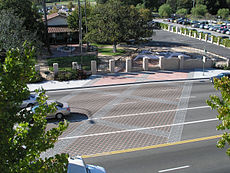Campo de Cahuenga | |
California Historical Landmark No. 151 | |
 Campo de Cahuenga | |
| Location | 3919 Lankershim Blvd. Studio City, California 91604 |
|---|---|
| Coordinates | 34°8′24″N 118°21′42″W / 34.14000°N 118.36167°W |
| Built | 1847 |
| Architect | Landon and Spencer |
| Architectural style | Mission Revival-Spanish Colonial Revival |
| NRHP reference No. | 72001602 |
| CHISL No. | 151 |
| LAHCM No. | 29 |
| Significant dates | |
| Added to NRHP | December 19, 2003[2] |
| Designated LAHCM | 13 November 1964[1] |
The Campo de Cahuenga, (/kəˈwɛŋɡə/ ⓘ) near the historic Cahuenga Pass in present-day Los Angeles, was an adobe ranch house on the Rancho Cahuenga where the Treaty of Cahuenga was signed between Lieutenant Colonel John C. Frémont and General Andrés Pico in 1847, ending hostilities in California between Mexico and the United States. The subsequent Treaty of Guadalupe Hidalgo of 1848, ceding California, parts of Colorado, Nevada, New Mexico, and Arizona (but not Texas since it had seceded from Mexico in 1836, declared itself a republic, and joined the union in 1845) to the United States, formally ended the Mexican–American War. From 1858 to 1861 the Campo de Cahuenga became a Butterfield Stage Station.




- ^ Los Angeles Department of City Planning (September 7, 2007). "Historic - Cultural Monuments (HCM) Listing: City Declared Monuments" (PDF). City of Los Angeles. Archived from the original (PDF) on July 25, 2011. Retrieved May 28, 2008.
- ^ "National Register Information System". National Register of Historic Places. National Park Service. April 15, 2008.



